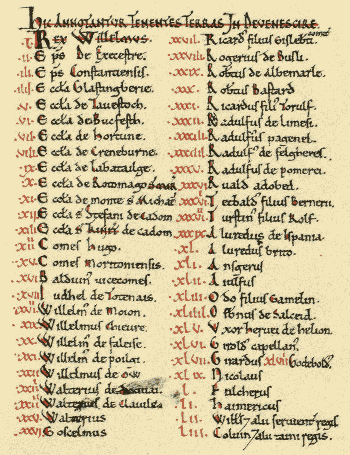What is the Doomsday Book?
The Doomsday (or Domesday) Book is one of the most useful sources we have for studying life in medieval England. What was it? And why does it have such an intimidating name? Learn more about this book and how you can use it in your research!
Background
Before getting to the book itself, it is necessary to first discuss the context in which the book was created.
The Domesday book was written in the 1080s in England. At this time, England had just undergone a major political change. In January 1066, the king of England, Edward the Confessor, died without an heir. Three claimants arose to claim the throne for themselves: Harold Godwinson from England, Harald Hardrada from Norway, and William of Normandy from France (later known as William the Conqueror).
A series of battles ensured, in which the claimants and their supporters fought for control of the monarchy. The decisive battle—the Battle of Hastings—happened in October 1066. Here, the last two surviving claimants, Harold Godwinson and William of Normandy, pitched their armies on the field of battle. Harold was killed; William of Normandy survived, won the battle, and became king of England.
The Battle of Hastings in 1066 is remembered as one of the most famous battles in early medieval Europe. It changed the course of history in England, starting a period when the English monarchy was controlled by a French dynasty. The Norman Invasion shaped politics, international relations between England and France, and even the English language. Many of the words used in English today entered the vocabulary from French words during this time.
Contents
After becoming king, William the Conqueror (now known as King William I) spent much of his reign consolidating his power. He commissioned the Domesday Book (or Doomsday Book, as spelled in modern English) in 1085 as part of this project of power consolidation.
The book assessed the resources and land distribution across England. It gave a picture of what was owed to the king through taxes or labor. It also showed how land and resources were distributed across the king’s subjects.
As it exists today, the book is 913 pages long, with two million Latin words. It describes 13,000 places across what is today England and Wales. Some sections in the book give overviews of the resources of particular areas. Other sections are incredibly specific, even listing the number of farm animals within a particular village.
When the book was first written, it was not given a particular title. Over decades, the book became known as the ‘Doomsday Book’ in a reference to the end times in Christian teaching—the final judgement day that no one can escape. The book was so named because, like Biblical Doomsday, whatever the book said about who owned a property was final; there could be no appeal.
Research
This book is one of the earliest documents we have about life in England. Indeed, it is the earliest public record in the country that is still surviving. It is especially useful because of its comprehensiveness. Oftentimes, people might write about their own lives or about the village in which they live. It is very unlikely for a document (especially one written so long ago) to summarize so much information about so many distant people and places. Indeed, there were few comparable documents until population censuses became commonplace in the 19th century.
The Domesday Book is available for research. It can be used to find out information about people, areas of the country, and landholdings. At the same time, the book is also a helpful resources for learning about the power of the English monarch in the 1000s: what resources did they have available to compiled this document? What information did the monarchy care to obtain? Finally, the book is useful itself for the history of books: rather than carrying this information through oral tradition or in a collection of different documents, why did the Normans decide to collect all of this information so clearly?
At the same time, not everything can be taken at face value, and historians using the document must also show judicious judgement in how they use the text. The text’s hundreds of pages all had to be written by hand (this was many centuries before the printing press!), meaning that the scribe often made small errors or typos. Additionally, there are notable errors in the arithmetical calculations in the book (also long before the invention of the calculator!).
The original copy of the Doomsday Book is housed in the British National Archives. While it is difficult to access the original in person, much of the book has been made available. Some of the book is discussed in the National Archives’ online exhibit on the topic. There are also modern publications of the book, which are more accessible.
Want to Learn How to Use Sources like the Domesday Book?
Circa teaches high school students how to analyze primary sources.


